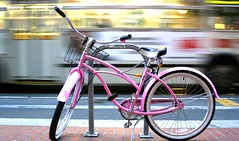You rode your bike to the office, but then a freak blizzard rolls in to render road conditions hazardous for your bike. Or you get a bad case of food poisoning. Or some dirtbag stole your wheels. Or the you forgot to charge your light batteries.
Any number of mishaps can happen to greatly increase the hassle of your bike commute. If public transportation is available in your area, I recommend learning how to use it before you need it. I and many other winter bike commuters always carry enough fare for an emergency bus ride. Here are the things you should know:
- You need to know the location of the nearest bus or train stop. Consider biking (if you can) to a slightly farther stop to minimize transfers. Most public transit agencies have schedules, stops and route information online. Search for “[Your City] public transit” if you don’t know the website. While Google Transit is now integrated into Google Maps, they only provide information for a very small number of transit agencies. You may need to hunt for it, but some transit providers and regional transportation management agencies have a trip planner somewhere on their website.
- Read the “How to ride” information on your transit agencies website. If you can’t find it, the usual procedure is to wave the bus down at the bus stop, load the bike on the front rack (if applicable), board the bus, pay the fare by inserting cash and change into the fare box, ask for a transfer (if applicable) and take your seat. You usually pull a cord or push a button to indicate your stop.
- You need a rough idea of the public transit schedule, along with how well connections mesh. If buses run every 10 minutes from 4 a.m. to midnight, for example, your planning is fairly easy. If buses run only once an hour or if service to your neighborhood stops at 7 p.m. and you absolutely must leave the office at 4:45 p.m. to make it there, preparation and quick thinking is somewhat more important. I keep transit schedules and maps pasted on my office door.
- Does your transit provider allow bikes? If bikes are permitted, are the onboard bike facilities rarely used, or do they fill up quickly? If the there’s no more bike space, what’s your Plan B?
- Some transit systems such as Denver RTD Light Rail require a “bike permit” to take a bike on board. Some may limit the times that bikes can board, or they may limit which stations that bikes can be loaded.
- How much fare is required to get you home? Do you buy a ticket or tokens beforehand, or can you pay when you board? Most transit agencies that accept fare on board require exact change. Of those that require exact change, you can pay extra — you just won’t receive change. For example, if the fare is $1.50, the fare box will accept $2.
- If you need to take multiple routes, does your transit agency accept transfers?
Don’t forget to check if your employer offers an “emergency ride home” service for alternate mode commuters. Some employers also participate in “EcoPass” type programs, in which they provide free or discounted transit passes to employees.
Anxiety is normal the first time you try a new mode of transportation. Study it out, bring schedules and maps with you, and try riding the bus when you have some free time. On a bus, try sitting near the front on the “passenger side” (the right side in the Americas, continental Europe and China, for example) where you can see out the front window so you can spot your stop.
